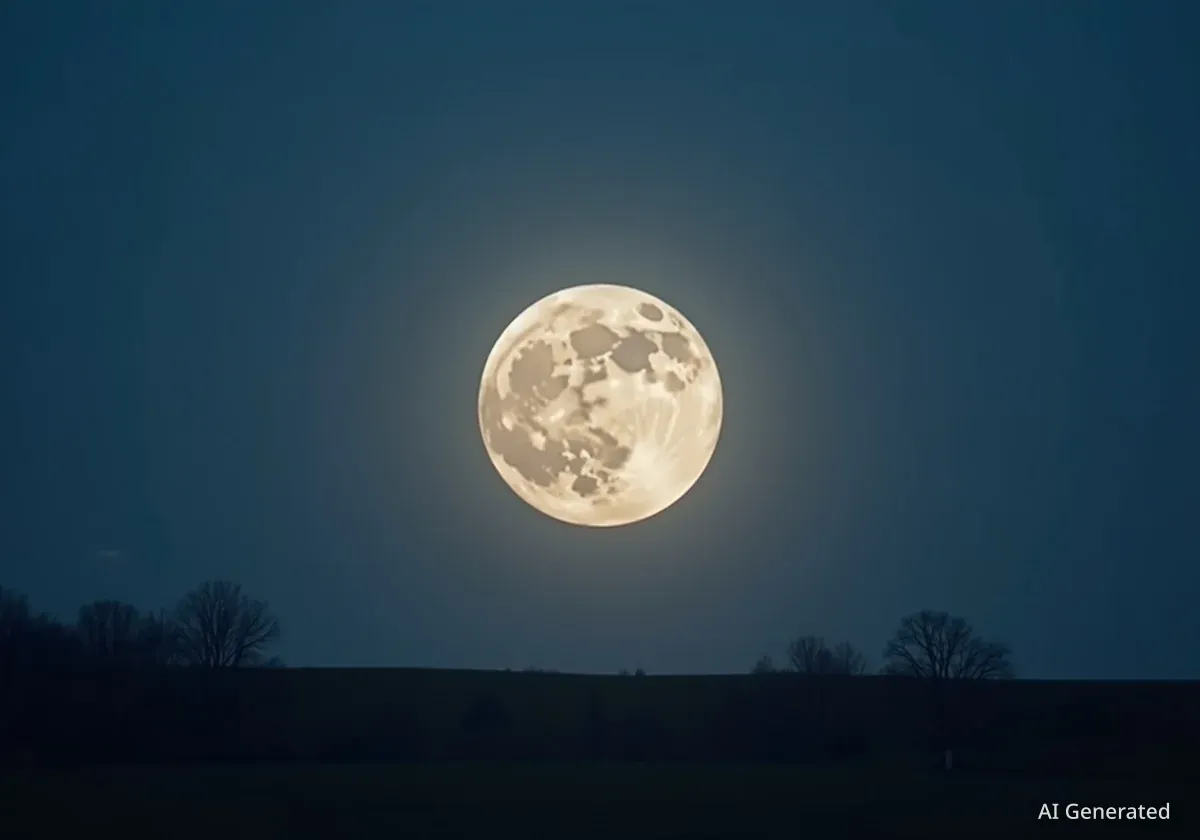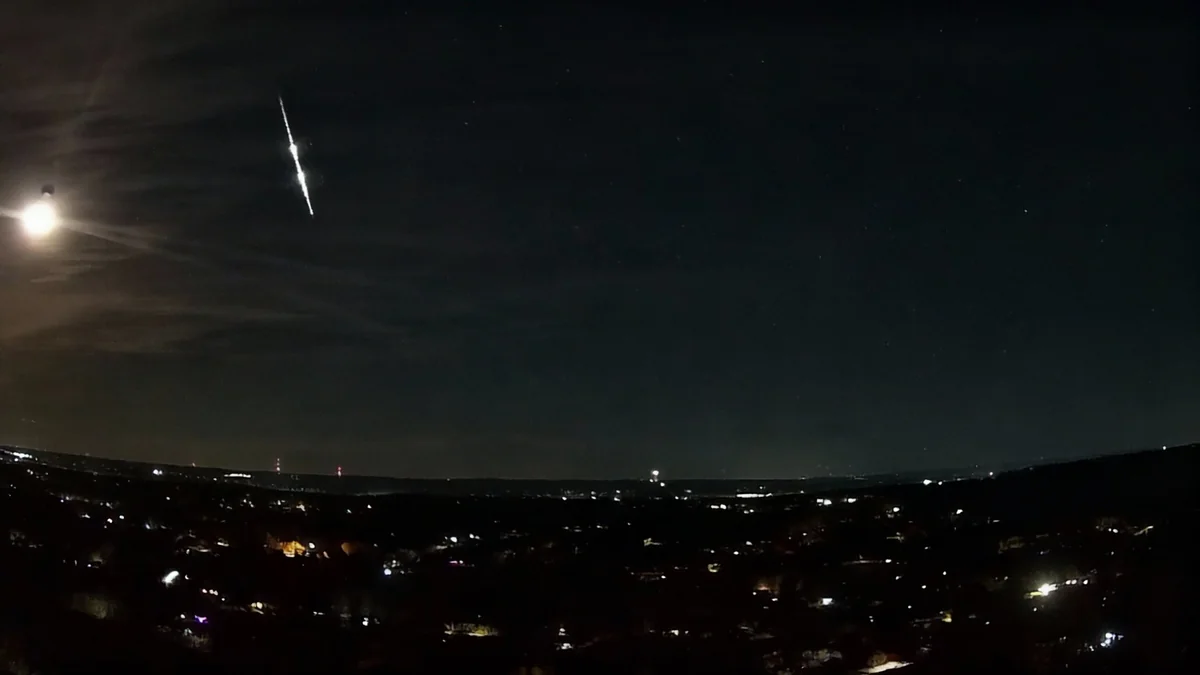The first supermoon of 2025 is scheduled to appear in the night sky on Monday, October 6. This celestial event, also known as the Harvest Moon, will offer skywatchers a view of a lunar disk that appears slightly larger and brighter than an average full moon.
The event will be visible globally, with prime viewing in the Americas occurring as the moon rises on the evening of October 6. The full moon phase will officially occur at 11:48 p.m. EDT (0348 GMT on October 7).
Key Takeaways
- The first supermoon of 2025, the Harvest Moon, will be visible on the night of October 6.
- A supermoon occurs when a full moon coincides with its closest approach to Earth, making it appear larger.
- The name "Harvest Moon" is given to the full moon closest to the autumnal equinox.
- The planet Saturn will be visible near the moon during the event.
Understanding the Harvest Supermoon
The upcoming celestial event combines two distinct lunar phenomena: the Harvest Moon and a supermoon. Each has its own scientific and historical significance that contributes to the viewing experience.
The Tradition of the Harvest Moon
The term "Harvest Moon" refers to the full moon that occurs nearest to the autumnal equinox, which marks the official start of fall in the Northern Hemisphere. The name has historical roots tied to agriculture.
Before the widespread use of electric lighting, farmers relied on the bright light of the full moon to extend their working hours into the night. This allowed them to gather crops from the fields, or "harvest the bounty," before the onset of colder weather. The light from this particular full moon was crucial for completing the season's work.
What is an Equinox?
The autumnal equinox happens in September in the Northern Hemisphere. On this day, the Earth's axis is not tilted toward or away from the sun, resulting in nearly equal amounts of daylight and darkness across the globe. The Harvest Moon is the full moon that falls closest to this date each year.
Defining a Supermoon
A "supermoon" is a non-technical term for a full moon that occurs when the moon is at or near its closest point to Earth in its orbit. This point is known as the perigee.
The moon's orbit around Earth is not a perfect circle; it is an ellipse. This means its distance from our planet varies. When a full moon aligns with its perigee, it can appear up to 14% larger and 30% brighter than a full moon at its farthest point, known as apogee.
While the difference may not always be dramatic to the casual observer, it contributes to a more impressive lunar display, especially as the moon rises above the horizon.
How and When to Watch
For observers in the United States and the rest of the Americas, the best time to watch the Harvest Supermoon will be on the evening of October 6. The moon will rise in the eastern sky around the time of sunset.
The peak of the full moon phase is precisely timed for 11:48 p.m. EDT. However, the moon will appear full to the naked eye for the entire night, as well as the nights immediately before and after October 6.
The Moon Illusion
When the moon is low on the horizon, it often appears much larger than when it is high in the sky. This is a well-known optical effect called the "moon illusion." The brain perceives the moon as larger when it can be compared to foreground objects like trees, buildings, or mountains. This effect will make the rising supermoon look particularly large and dramatic.
What to Look For
As the supermoon climbs above the horizon, viewers may notice its color. The moon often takes on a golden, orange, or reddish hue when it is low in the sky. This is because Earth's atmosphere scatters shorter, bluer wavelengths of light while allowing longer, redder wavelengths to pass through to our eyes.
This is the same principle that causes sunrises and sunsets to appear red and orange. As the moon rises higher, it will gradually return to its more familiar silvery-white color.
Celestial Objects Near the Moon
The Harvest Supermoon will not be alone in the sky. Stargazers will have the opportunity to spot a prominent planet and a well-known star pattern nearby.
Finding Saturn
The gas giant Saturn will be visible shining brightly near the moon. According to astronomical charts, the planet will be located approximately 15 degrees to the upper right of the full moon as it rises.
A useful method for estimating distances in the night sky is to use your hand. A clenched fist held at arm's length covers about 10 degrees of the sky, making it a simple tool for locating celestial objects relative to one another.
The Great Square of Pegasus
Directly above the lunar disk, observers should be able to identify the Great Square of Pegasus. This is a large asterism, or recognizable pattern of stars, that forms a prominent diamond shape in the autumn sky.
The four stars that form the corners of the square are part of the constellation Pegasus. Its position above the moon will make it an easy landmark for those looking to orient themselves with the autumn constellations.
Photographing the Supermoon
The Harvest Supermoon presents an excellent opportunity for astrophotography. For best results, photographers should consider using a DSLR or mirrorless camera with a telephoto lens to capture details on the lunar surface.
Key considerations for capturing the event include:
- Using a tripod: A tripod is essential to keep the camera steady and prevent motion blur, especially when using long focal lengths.
- Manual focus: Use your camera's live view to magnify the moon and manually adjust the focus until it is perfectly sharp.
- Proper settings: A good starting point for camera settings is a low ISO (100-200), a mid-range aperture (f/8 to f/11), and a relatively fast shutter speed (around 1/125s). These will need to be adjusted based on conditions.
- Timing: Photographing the moon at moonrise allows you to include interesting foreground elements, which can add scale and context to your images.
This event provides a great chance for both seasoned astronomers and newcomers to enjoy a beautiful and significant celestial display.





